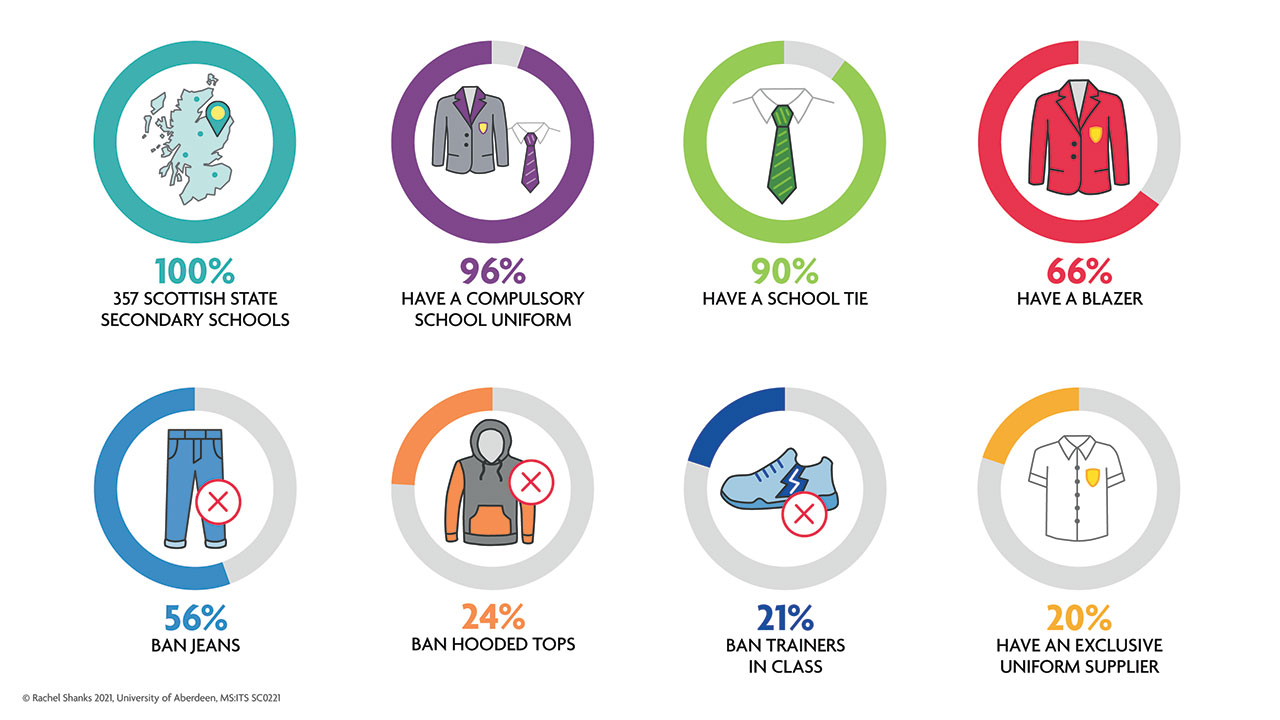
School uniform policies promote a message that uniforms can achieve many things, but there is limited research evidence to back up many of these claims, explains Dr Rachel Shanks, School of Education at the University of Aberdeen.
The issue of compulsory school uniforms was recently debated at the French National Assembly. The proposals were defeated, and so this provides an opportunity, on the other side of the Channel, to reflect on what it is claimed that school uniforms achieve and whether these claims are well-founded.
In the UK and in many former British colonies, from the Caribbean to Singapore, there is a presumption that a specified uniform is worn to school (a hard dress code). Uniform requirements may cover what is worn to and from school as well as what is worn in the classroom and for Physical Education (PE) activities. In contrast a soft dress code is less stringent and may cover a small number of items that cannot be worn.
To understand the reasons given by schools to have uniform, research was undertaken with a group of students at the University of Aberdeen. The school handbooks and uniform and dress code policies of all 357 publicly funded secondary schools in Scotland were collected and analysed. It was found that 96% of the secondary schools had a compulsory uniform and schools gave many different reasons for this. The reasons included school ethos, identity, pride or sense of belonging and safety, security and reducing truancy. Other reasons were to prevent competition and discrimination, for discipline and to reduce bullying. Some schools referred to employability and replicating a workplace, financial benefits of uniform, the reputation of the school and to improve attitudes to learning and improving standards of work.
In line with some of the secondary schools’ reasoning, in the recent consultation process on national guidance the Scottish Government stated: ‘It is recognised that school uniform plays an important part in the engagement of pupils with school, in promoting a sense of identity, belonging and connectedness to school.’ However, these claims have been neither proved nor disproved. The Education Endowment Foundation has looked into research on school uniform and has not found evidence of a link between wearing a uniform and an improvement in learning. While research in the USA has found that teachers’ perceptions of being safer or more secure increased after the introduction of school uniforms, students in the same schools did not report this and there is no research on this in the UK context.
It is often stated that school uniform provides a ‘level playing field’. This links to preventing competition and discrimination between pupils as well as improving discipline and potentially reducing bullying. The idea is that socio-economic differences between pupils are more hidden. The difficulty is that school uniform in Scotland can cost more than the local authority school clothing grant that is provided to eligible families. For secondary school pupils in Scotland the national minimum school clothing grant is currently £150 but in 2020 The Children’s Society reported that the average costs were £337 over a school year. Furthermore, 20% of secondary schools had exclusive supplier arrangements which the Competition and Markets Authority has found to make uniform more expensive. Schools provide a list of things to wear at school and for PE and a list of clothes or shoes not to wear. Banning everyday items such as jeans and trainers can make uniform more expensive and thus add more to the cost of the school day.

School uniform requirements at secondary schools in Scotland (Rachel Shanks)
In the analysis of Scottish secondary school uniform policies, we found that young people’s bodies were simultaneously being made to look the same, while still creating divisions and hierarchies. Uniforms, especially ties, changed as pupils progressed through school. Girls all had to wear ties at the schools where it was compulsory, but girls do not usually wear ties. In over 50 secondary schools, it was said that wearing a uniform would be useful for pupils’ employability and their future careers. However, workwear is becoming more relaxed with G7 leaders making a point of no longer wearing ties at their international summits.
A review with a focus on public health concerns found no direct link between uniform and academic performance. In fact, in that review negative impacts were found on the health of girls, and those from an ethnic or religious minority as well as for gender-diverse young people. This was due to uniform policies and the clothes they mandated not matching young people’s physical or socio-cultural needs. Instead of creating a level playing field some uniform policies can, therefore, make things more uneven at school.
So, what can school uniforms achieve? One future possibility for school uniforms making a positive difference could be in reducing textile waste. Good quality clothes can have up to 30 years of wear rather than one school year. In landfill clothes take between 200 and 500 years to break down. If successful models of reusing uniform could be replicated on a large scale then sustainable, reusable school uniform would be a great achievement.
References
Olsson, A., & Shanks, R. (2022). Employability and school uniform policies: Projecting the employer’s gaze. Childhood, 29(4), 628–645. https://doi.org/10.1177/09075682221108838
Shanks, R. (2022). School Clothing Grant in Scotland Policy Briefing. University of Aberdeen. https://abdn.pure.elsevier.com/files/219977936/Shanks_2022_School_Clothing_Grant_in_Scotland_Policy_Briefing.pdf
Shanks, R., & McKinney, S. J. (2022). Cost and Affordability of School Uniform and Child Poverty, Scottish Educational Review, 54(1), 26-48. https://doi.org/10.1163/27730840-54010003








